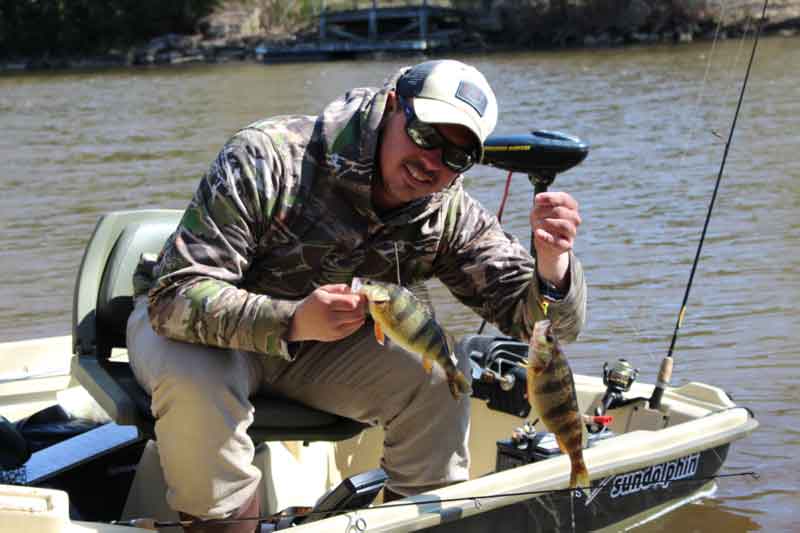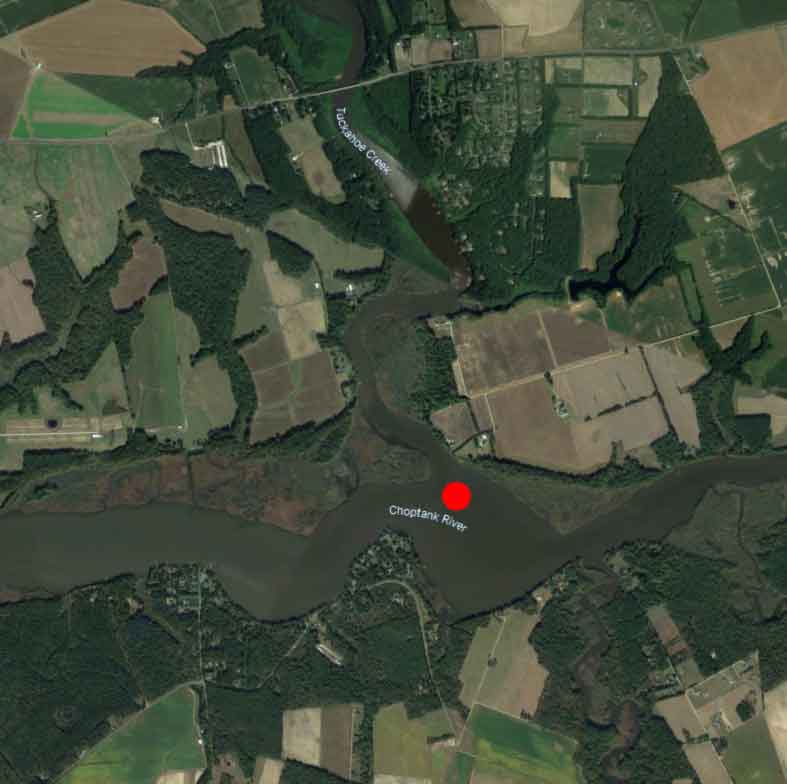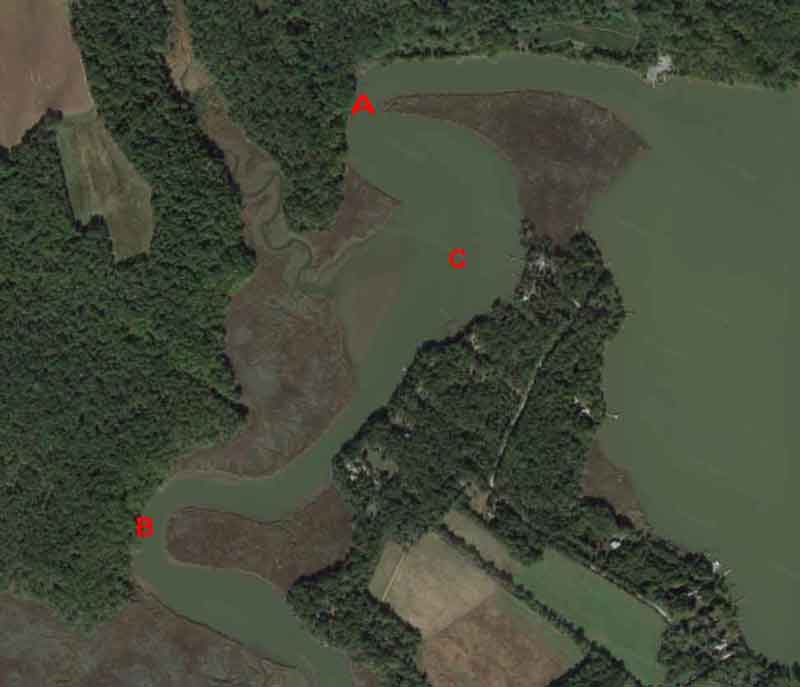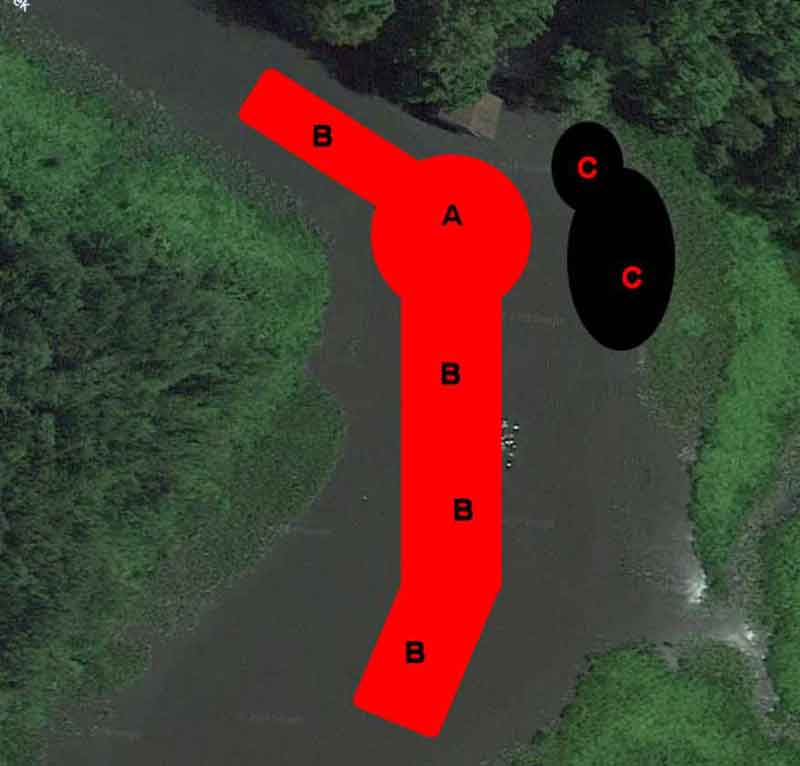Your spouse took off for a long weekend in Bimini, the weatherman calls for sunny skies, and you have cabin fever so bad you could chew on a BKD? Sounds to us like it’s TIME TO FISH! And if you live within the distribution area of FishTalk, it’s a sure bet there’s a Chesapeake or coastal bay tributary within driving distance. That means there are fish out there just waiting for you to catch ‘em, because Mid-Atlantic region tributary creeks hold fish all winter long. The secret to finding fast action and filling the fridge with fillets during the chillier months of the year? Locating holes.

Virtually all tributary creeks have some level of tidal current, which scour out deep holes surrounded by large areas of much shallower water. Being able to locate them is a key factor in discovering productive hotspots. Two geographic features are dead giveaways: junctions, and bends.
Creek Junctions
Junctions between the main creek and an offshoot often have a deep hole close by. You’ll need to use a depth finder to nail down the specific location, because it may be slightly up-stream or down-stream of the junction. And sure, there will be junctions where the depth remains static; that’s a sign that the feeder doesn’t have much current, so this probably isn’t a prime fishing spot anyway.

A prime example can be found on the Eastern Shore where Tuckahoe Creek meets the upper Choptank, forming a deep hole where their waters mix. It’s important to note that not every feeder creates a hole like this, but as you cruise up or down a river or creek you should always take a look-see.
Creek Bends
Bends in the creeks and rivers are more reliable for finding holes, and in some cases, every bend on a creek will have one for miles on end. The deepest parts are usually on the far outside edge of the bend, however, sometimes you’ll find the sharpest drop-off (and the most fish) right off the point sticking out into the middle of the bend.

Nanjemoy Creek (shown above), off the Potomac River, provides a case-study in awesome holes formed by bends. “A” and “B” are sitting over holes hitting the 20-foot range, while “C” marking the water in-between these holes is a mere two or three feet deep in most areas. Yeah – you can guess where the fish are.
Junctions and bends will occur together in a few places, and spots like this offer hordes of potential. Watts Creek, another Choptank feeder, is a great example. There’s a pavilion built out over the water at the state park here, right in front of the deepest hole on the creek. On the far side of the hole a small feeder comes in, and the hole extends farther than one would expect beyond the bend. Capping it all off, there’s a large mud flat on one edge.

You can see the pavilion itself, the brown square at the center top of this picture. Right in front of it, the red circle (A) is the deepest hole in the creek and goes beyond 20 feet. It has a bit of a channel leading into it (B), with depths in the low teens. At the tail end, however, where a secondary feeder also flows in (the lowermost three Bs) the deep water extends for a much longer distance and is in the upper teens. The zone marked “C” is the shallow flat, which on extreme low tides, is exposed mud. This particular creek bend and ones like it are exceptionally good for catching winter yellow perch, catfish, and the occasional bass or crappie.
Fishing the Tide
In tidal creek holes like these, during the late winter months you’ll commonly find fish including yellow and white perch, catfish, crappie, and bass. The fresher the water, the better your chances of finding crappie and bass. Farther down-river you’re more likely to locate white perch or even hook into a stray striper. In all cases, however, the tidal cycle usually plays a huge role.
The bottom line: falling and low tides concentrate fish in these deep holes. Sometimes they’ll be biting best earlier or later during low water, but the shallower the surrounding areas become, the more densely the fish pack in. On rising tides it’s common to see fish on the meter but have trouble getting them to eat. And on flood tides, fishing over the shallow flats adjacent to the deep holes sometimes produces – particularly on clear, bright days, when the shallower waters warm up in direct late morning and early afternoon sunlight. Picking up pickerel becomes likely when fishing these shallower areas, too.
Tidal Water Tactics
Quite often, the simplest method is best for pulling fish out of these holes: rig up a top-and-bottom rig with hooks in the number-four to -six size range, bait ‘em up with bull minnow hooked through the lips, put on a half-ounce or so of weight (you’ll need a bit more when the water’s moving full-tilt) and toss the rig into the deepest section of the hole. For shoreline anglers in particular, this is usually the best way to go. At times grass shrimp will be a top bait, though they often don’t stay on the hook quite as well.
If you want to get a bit more artistic, you can try just about any tube, hair jig, or dart in the two- to three-inch range, either jigged or bounced along the bottom. Tipping it with either a small minnow or a grass shrimp will boost the number of bites.
When water levels are on the rise and you want to target fish up over shallower mud flats, ditch the bottom rig. Instead, rig a shad dart or a marabou jig under a bobber and set it just deep enough that the bait sits about six inches above the bottom. You can also cast and retrieve small lures over the flats, but quite often these areas are covered with leaves, branches, and other detritus, and working a lure along the bottom without becoming fouled may be difficult.
So, which tidal creek should you give a shot, when the next weather-window arrives? Take you pick – virtually all of ‘em in our region offer good potential, once you figure out where those holes are.
Species Specific Tidal Creek Fishing Tips
If you want to target one species or another in specific while fishing tidal creek holes, remember:
- Bass – The best catches often come at higher tides, over shallow water very close to the holes. Artificials may work but don’t shy away from the simple minnow under a bobber – tidal water largemouth love ‘em.
- Catfish – Stick with minnow or cut bait, set dead on bottom. Cast out and just let it sit until the rod tip jiggles.
- Crappie – This species can be frustratingly difficult to locate in tidal creeks, with dozens of great-looking spots proving fruitless. But when you find a location that holds one fish, you often find a massive pack. So keep on the move and try different spots until you catch one. Then stick close, and focus your efforts in the immediate vicinity.
- White perch – Grab a box of grass shrimp, their favorite snack.
- Yellow perch – Minnows on bottom in the very deepest spot usually can’t be beat; sometimes they like a bit of motion, but other times they hit a static bait better.
For more info on winter fishing in tidal tributaries and creeks, check out:
- Winter Yellow Perch Fishing at Tidal Creeks
- Pounding Winter White Perch
- Tidal River Blue Catfish
- Winter Pickerel Fishing Tactics That Work
Sign up here to get the weekly FishTalk Chesapeake Bay and Mid-Atlantic fishing reports in your email inbox, every Friday by noon.